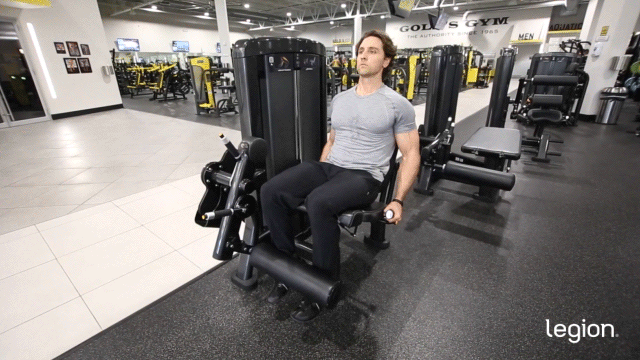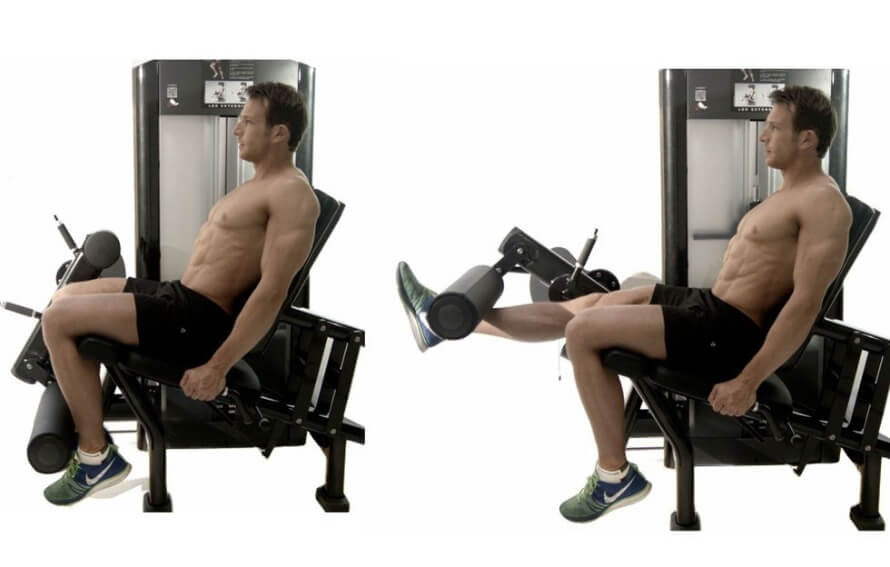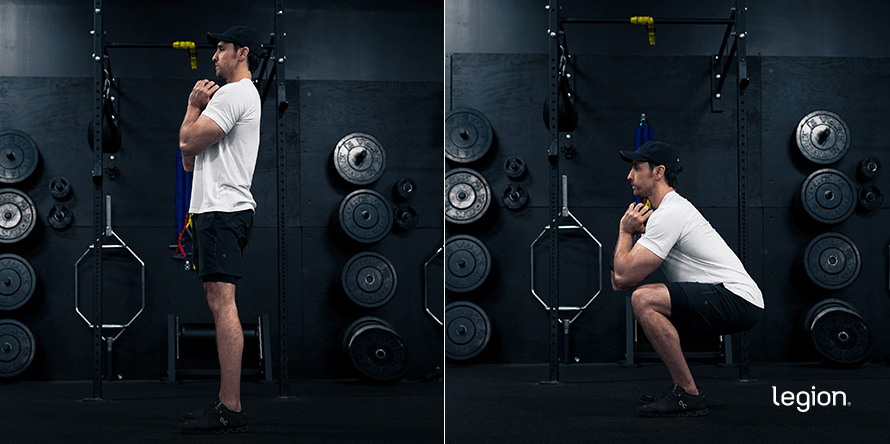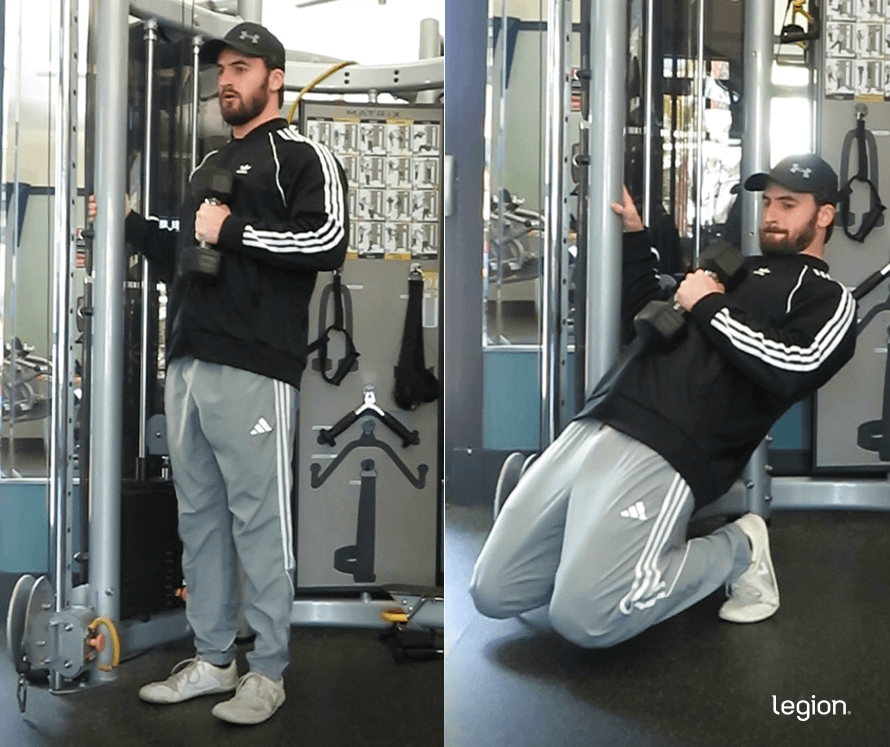The leg extension is one of the most popular quad isolation exercises.
It’s well-liked because it’s easy to learn and perform, less tiring than most other leg exercises, and effectively trains your quads.
In this article, you’ll learn what the leg extension is, why it’s beneficial, which muscles it works, how to perform it with proper form, the best alternatives, and more.
What Is the Leg Extension Exercise?
The leg extension is a quad isolation exercise involving a leg extension machine.
To perform it, you sit on the leg extension machine seat with your knees bent, lift a weight stack by pressing your shins into a pad, and extend your legs until they’re straight.
Leg Extension: Benefits
The leg extension effectively trains the four muscles of the quadriceps: The rectus femoris, vastus lateralis, vastus medius, and vastus intermedius. This makes it ideal for building muscle in your upper legs.
It’s also easier to learn and perform than dynamic leg exercises, such as the walking or reverse lunge, step-up, or Bulgarian split squat, making it a great option for new weightlifters. Additionally, unlike many quad exercises, such as the back and front squat, it places no stress on your spine. Hence, it’s a viable way to train your legs if you have back issues.
Another benefit of the leg extension is that it allows you to train your quads when your lower back is tired.
During most squat variations, your lower back muscles work hard to stabilize your upper body. If you only do free-weight leg exercises like these, your back may fatigue faster than your quads. This may mean you have to stop training when your back is tired, even though your quads could handle more.
The leg extension offers a workaround in this scenario. It allows you to train your quads after your back is fried, ensuring you train your legs with enough volume to build muscle and get stronger without your lower back becoming a limiting factor.
Leg Extension: Muscles Worked
The main muscles worked in the leg extension are the quadriceps, or “quads,” the muscle group on the front of your thighs that comprise the . . .
- Rectus femoris
- Vastus lateralis
- Vastus medialis (which includes the vastus medialis oblique, or “VMO”)
- Vastus intermedius
Here’s how these muscles look on your body:

How to Do Leg Extensions
To master the leg extension exercise, split it into three parts: set up, extend, and descend.
1. Set up.
Sit on the seated leg extension machine seat and adjust the back pad so your knees are just in front of the edge of the seat. Adjust the lower leg pad so it touches your shins right above your ankles and puts your feet as close to your butt as possible.
If there’s a thigh pad, ensure it’s snug but comfortable when seated.
2. Extend.
Grab the handles, engage your core, and push your feet toward the ceiling, extending your legs until your knees are straight.
3. Descend.
Bend your knees to lower your feet and return to the starting position. This should mirror the “extension.”.
Don’t try to lower the weight too slowly. The entire “descent” should be controlled but only take about a second.
Here’s how it should look when you put it all together:

Leg Extension: Alternative Exercises
1. Single Leg Extension

The single leg extension lets you train each leg independently, helping you find and fix any muscles or strength imbalances you might have. The form is the same as the regular version, only instead of lifting the weight with both legs, you alternate between your legs with each rep.
2. Reverse Nordic Curl

The reverse Nordic curl is an excellent leg extension alternative if you don’t have access to a leg extension machine. To perform it, kneel on the floor and squeeze your glutes so that your body forms a straight line between your head and knees. Lean backward as far as you comfortably can, then straighten your knees until your torso is perpendicular to the floor.
While the reverse Nordic curl is an effective quad exercise, it can be tough on your knee joints, so only do it if you can perform it through a full range of motion without discomfort.
3. Goblet Squat

The goblet squat trains your quads to a high degree. To execute it, hold a dumbbell by one end with both hands in front of your chest. Place your feet a little wider than shoulder-width apart and point your toes out slightly. Squat down until your thighs are parallel to the floor, then stand up and return to the starting position.
4. Sissy Squat

The sissy squat is an effective quad exercise that you can perform using your body weight or while holding a dumbbell against your chest (shown above). Its main advantage is that it trains your quads through a full range of motion and in a stretched position, which is important for maximizing growth.
Begin the sissy squat by standing with your feet shoulder-width apart, holding onto a sturdy object with your dominant hand. Squeeze your glutes, then bend your knees, allowing them to move forward over your toes. As you descend, let your body lean backward, and your heels come off the floor.
Lower yourself as far as you comfortably can or until your glutes are 6-to-12 inches from your heels, then reverse the movement and return to the starting position.
5. Dumbbell Leg Extension

The dumbbell leg extension is a viable alternative to the leg extension when you don’t have access to a leg extension machine. It involves grasping a dumbbell between your feet while sitting on a bench, extending your legs by straightening your knees, then lowering the weight.
Scientific References +
- Zabaleta-Korta, Aitor, et al. “The Role of Exercise Selection in Regional Muscle Hypertrophy: A Randomized Controlled Trial.” Journal of Sports Sciences, vol. 39, no. 20, 10 July 2021, pp. 2298–2304, https://doi.org/10.1080/02640414.2021.1929736. Accessed 18 Mar. 2022.
- Pedrosa, Gustavo F., et al. “Partial Range of Motion Training Elicits Favorable Improvements in Muscular Adaptations When Carried out at Long Muscle Lengths.” European Journal of Sport Science, 23 May 2021, pp. 1–11, pubmed.ncbi.nlm.nih.gov/33977835/, https://doi.org/10.1080/17461391.2021.1927199. Accessed 27 Sept. 2021.










